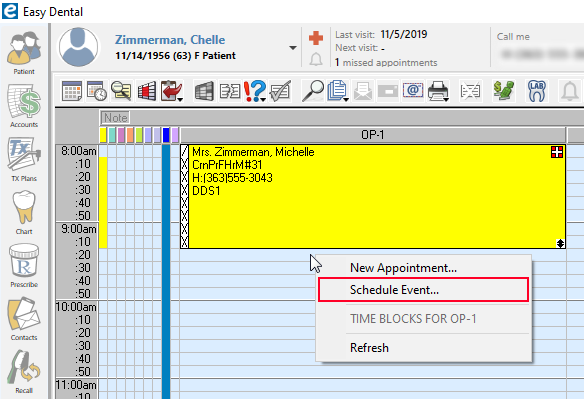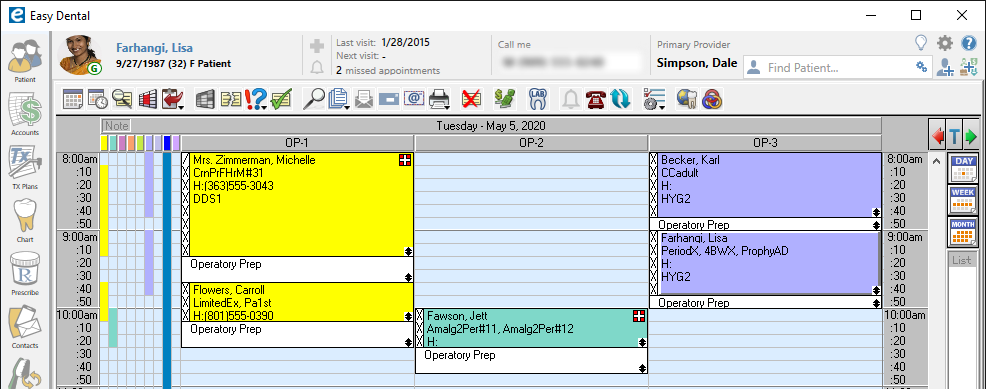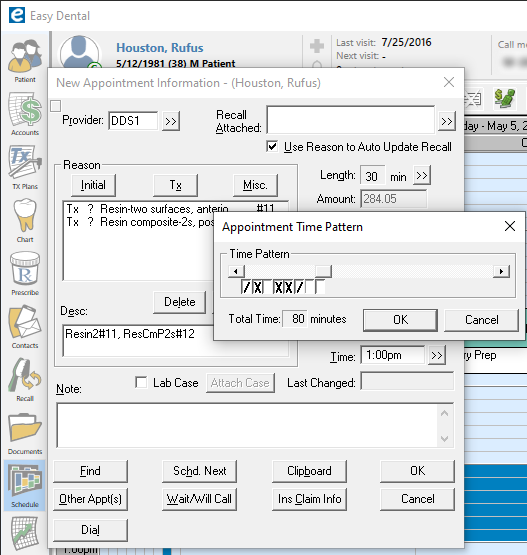When your practice re-opens and you begin scheduling patients again, you should keep in mind the time it will take to re-set each operatory for a new patient. You will need to allow time for surfaces to be wiped down and disinfected, time for staff to change gloves and masks, and so forth.
This can be accomplished using one of two methods: scheduling events between appointments, or adjusting appointment time patterns.
Scheduling Events Between Appointments
When an appointment is created in the Schedule, right-click the time slot immediately following it, and select Schedule Event.

Then follow these steps:
- Under Event Time, set the Start and End time based on how long it will take you to prepare the operatory for a new patient.
- Under Event Days the Start and End date should match with the appointment you created. If it does, you don’t need to worry about items that may be selected under Select Days of the Week.
- Under Operatories, make sure the operatory that corresponds to the appointment is selected.
- Enter a Description for the event, such as Operatory Prep.
- Select an Event Color that will stand out against the appointment color it will be seen against.
- Add Notes as needed to explain the event. These notes appear when you hover your mouse over the event in the Schedule.
- Click OK to create the event and add it to the Schedule.

It only takes a few extra seconds to create an event after you add an appointment to the schedule but doing so can help to ensure that your staff has enough time to create a clean, safe, disinfected room for both patients and providers.

If something went wrong and the event was created incorrectly, you can edit an event by right-clicking it and selecting Edit Event, or delete it completely by right-clicking it and selecting Delete Event.
Adjusting Appointment Time Patterns
The Appt Length field in the Appointment Information dialog box allows you to specify the amount of time needed for the appointment.
You can adjust the time pattern to add extra time blocks to the end of the appointment to represent time needed for surfaces to be wiped down and disinfected, time for staff to change gloves and masks, and so forth.
When you edit an appointment’s time pattern from the Schedule, you can specify how much of the appointment time will be assigned as Provider Time (where the primary provider will be in the room), Assistant Time (where the assistant, but not the provider, will be in the room), and Chair/Clear Time (for cleaning and other safety precautions).
To change an appointment’s time pattern:
- In the Schedule, double-click a patient’s appointment.
- Click the Length search button to open the Appointment Time Pattern dialog box
- Use the left and right arrows to increase or decrease the time.
- Click each box, which represents a block of time, to assign Provider (X), Assistant (/), or Chair Time ( ) to the block. The corresponding symbol will appear in the time block indicating the type assigned. Use the Chair Time option to represent your extra cleaning precautions.
- Click OK to save your changes.

When viewing an appointment in the schedule, the left side of the appointment indicates the time pattern for each time unit of the appointment.
Whichever method you decide to use, make sure that all team members assigned to scheduling appointments are trained on how correctly allow for extra time between patients. It’s important for the safety or your patients and your staff, and will help to keep your scheduling times more accurate.




